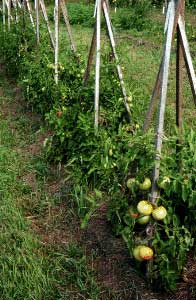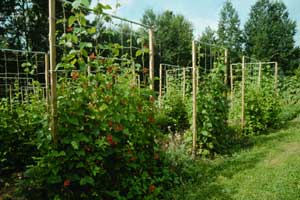Providing Support For Tomatoes
Vertical growing of tomato plants saves space and discourages slug pests. It also allows fruit access to light for earlier ripening, better air circulation and cleaner fruit.
 Stakes: Use sturdy stakes, 6 to 8 feet tall and an inch or more wide with pointed bottoms. Drive them into the ground about 3 inches from the plants on their north side down a foot or more when planting the seedlings to avoid root damage later. Tie plant stems to the stakes with soft but strong 18-inch fabric strips, or padded twine. As the stem grows, every 12 to 18 inches knot the tie around the stake first, then wrap it loosely around the main stem and knot it.
Stakes: Use sturdy stakes, 6 to 8 feet tall and an inch or more wide with pointed bottoms. Drive them into the ground about 3 inches from the plants on their north side down a foot or more when planting the seedlings to avoid root damage later. Tie plant stems to the stakes with soft but strong 18-inch fabric strips, or padded twine. As the stem grows, every 12 to 18 inches knot the tie around the stake first, then wrap it loosely around the main stem and knot it.
Cages: Center tall, sturdy wire cages 15 to 18 inches in diameter over each tomato seedling, pushing it into the soil about 6 inches or tying it to 3 or 4 short supporting stakes. As they mature, the plant’s many branches protrude through the wire which supports them. Choose wire with openings wide enough to reach your hand in to pick the tomatoes. Indeterminate varieties need a cage about 5 feet tall; but determinate (bush) varieties do fine in cages 2½ feet tall. Tomatoes growing in cages don’t need pruning.
 Trellises: Support either type of tomato plant on a trellis system of nylon mesh netting. As they grow tall, fasten the main stems to the trellis netting with cloth or other soft ties. Weave the lateral branches in and out of the mesh to support them and their fruit.
Trellises: Support either type of tomato plant on a trellis system of nylon mesh netting. As they grow tall, fasten the main stems to the trellis netting with cloth or other soft ties. Weave the lateral branches in and out of the mesh to support them and their fruit.
For more discussion about this topic see our file Vertical Growing In The Vegetable Garden
The following is an extensive discussion about staking tomatoes by the well-know garden writer Shep Ogden.
|
Trellising and Training Tomatoes Shepherd Ogden
This is probably the most extensive and valuable discussion of staking tomatoes ever written. It has been written by our good friend Shep Ogden and fellow garden writer and advocate for an organic life. In my travels to gardens and farms around the world, I've seen a variety of inventive ways to trellis tomato plants. Some of the trellises are particularly attractive, others are surprisingly strong, and still others are rather elaborate. Compost Cages An ingenious American trellising method. Make a 4-foot-diameter cage (minimum) from fencing or concrete reinforcing wire. Build a compost pile inside it. The following season, plant tomatoes around the perimeter and train them to grow up the outside. Rain falling on the compost will feed the plants.
Single Stake The most common method in the United States. Pound a solid stake a foot or two into the ground, and tie a single vine to it as it grows. Six-foot 1- x 1-inch stakes are usually set 2 to 3 feet apart, 2 feet deep, in rows 3 to 4 feet apart.
Bar-and-Twine Trellis A home-scale variation of a widely used European trellis. Sink 8-foot-tall 2 x 2 rot-resistant posts 18 inches in the ground, 5 feet apart, and join them at the top with electrical conduit flattened and drilled at the ends. Tie strings to the base of each plant with a nonslip knot, then loop over the top bar. Braid stems with the strings as the plants grow.
Dutch Spiral This system is a high-tech single-stake method. Set the metal post 1 foot into the ground; as the pruned, single-stem tomato plant grows, it intertwines itself with the stake.
Tall Cage of Concrete Reinforcing Wire Almost as popular among American gardeners as the single-stake method, these cages are taller, sturdier versions of the basic tomato cage. Make one from 4-foot-wide concrete reinforcing wire, available at most building-supply stores. Set a stake just inside the cage and fasten the wire to it.
Long Row For this English-style trellis, set 8-foot-tall 4 x 4s 2 feet into the ground at the ends of a 20- to 50-foot row. Run a 9-gauge wire from anchors beyond each end over the top and tighten with a turnbuckle. Run twine from the plant base to the wire or tie bamboo stakes to the wire every 2 feet, and tie the stems to grow up the twine or stakes.
A-Frame A variation on the single stake is the A-frame lean-to. Use 2 x 4s for end posts and top; 1 x 2s or 2 x 2s elsewhere. When end posts are sunk slightly in the ground, it is self-supporting. The base is 3 to 4 feet, and the vines are trained, one every 18 to 24 inches, up both sides.
Quadrapod Similar to methods used in the Far East and the Caribbean, this system uses 3/4-inch, 8-foot bamboo stakes lashed together with twine. Set the canes 2 feet apart in every direction and then lean them together.
Quonset Hut Cage Common on Spanish farms, this system uses concrete reinforcing wire. Place hoops over the plants when they're 6 inches tall. They'll grow up through the wire grid and bear fruit on the top, away from pests. A row cover fastened over the cage at planting time makes a small grow tunnel and promotes early fruiting.
Ties That Bind Use untreated twine to attach your tomatoes to the trellis. That way at the end of the season, you can simply cut the lines at the top and the tomato stems at the bottom, roll up the whole affair, and throw it on the compost pile. Basic Tomato Cage Place these widely available funnel-shaped wire supports over plants when they're 6 inches tall; as plants grow, their branches drape over the cage, keeping fruits off the ground. Used world wide.
Tastiest Tomatoes Tomatoes' flavor quality is affected by the ratio of fruit to foliage. That means that the more plant there is for a given amount of fruit, the better the fruit will taste, all else being equal. The bush kinds, so loaded down with fruit on compact plants, just don't have enough flavor to go around. So if you want great-tasting tomatoes, grow only indeterminate types. And if you grow them, I recommend that you trellis them. Convenience or Flavor? The most basic distinction among tomatoes is between the bush and vine types. Bush tomatoes are called determinate, because genetic programming causes them to grow a certain number of branches and flower clusters and then stop, much the way that peppers and eggplants grow. Because of their fixed habit, they are considerably less trouble to grow than vining or indeterminate tomatoes. They are generally earlier as well. But bush tomatoes are usually less disease-resistant, and the flavor of a bush tomato will rarely match that of fruit from the larger plants. There just isn't enough plant to produce as good a fruit. Why Trellis Indeterminates?
Indeterminate tomatoes are true vines. Being perennial they will continue to grow, sprouting new leafy and fruiting branches, until the plant is killed by disease or frost, or the growing tip is damaged or removed. I have seen 18-month-old greenhouse tomato plants fifty feet long! In long-season areas, outdoor plants trellised against the wall of a house may well climb to the roof. Trellising the plants can be a fair amount of trouble, but -- particularly if you have a small garden -- it's worth it. With a bit of attention to training the plants, you can get them to bear almost as early as the bush types. Actually, both bush and vining tomatoes should be trellised, but each kind requires a different kind of support. Training Indeterminate Tomatoes Whatever type of trellis you choose, attach the plant to the trellis in the same way. First, tie a nonslip knot about 4 inches in diameter around the base of the plant. Then, before cutting it off the spool, run the other end of the line up and over the top of the trellis. Cut it off about 2 feet beyond the top bar, and tie this loose end with a granny knot that will come out easily later. The usefulness of this extra string will become apparent later.
Trellises Mean More Care Trellised tomatoes need more water and repeated sucker pruning. We're in the cold zone 4, so we give the soil a week to warm up in the strong June sun, then lay a section of soaker hose along the center of the bed. Next, we erect the trellis and cover the entire bed with 8 to 12 inches of hay mulch to prevent rain from splashing early blight spores up onto the plants. |

